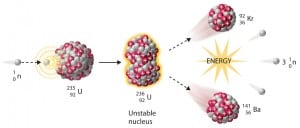Nuclear Reactors

A nuclear reactor is a key device of nuclear power plants, nuclear research facilities or nuclear propelled ships. Main purpose of the nuclear reactor is to initiate and control a sustained nuclear chain reaction. The nuclear chain reaction is initiated, sustained and controlled just via the free neutrons. The term chain means that one single nuclear reaction (neutron induced fission) causes an average of one or more subsequent nuclear reactions, thus leading to the possibility of a self-propagating series of these reactions. The “one or more” is the key parameter of reactor physics. To raise or lower the power, the amount of reactions, respectively the amount of the free neutrons in the nuclear core must be changed (using the control rods).
Neutron diffraction

Source: www.psi.ch
Neutron diffraction experiments use an elastic neutron scattering to determine the atomic (or magnetic) structure of a material. The neutron diffraction is based the fact that thermal or cold neutrons have the wavelengths similar to atomic spacings. An examined sample (crystalline solids, gasses, liquids or amorphous materials) must be placed in a neutron beam of thermal (0.025 eV) or cold (neutrons in thermal equilibrium with very cold surroundings such as liquid deuterium) neutrons to obtain a diffraction pattern that provides information about the structure of the examined material. The neutron diffraction experiments are similar to X-ray diffraction experiments, but neutrons interact with matter differently. Photons (X-rays) interact primarily with the electrons surrounding (atomic electron cloud) a nucleus, but neutrons interact only with nuclei. Neither the electrons surrounding (atomic electron cloud) a nucleus nor the electric field caused by a positively charged nucleus affect a neutron’s flight. Due to their different properties, both methods together (neutron diffraction and X-ray diffraction) can provide complementary information about the structure of the material.
Applications in Medicine
Medical applications of neutrons began soon after the discovery of this particle in 1932. Neutrons are highly penetrating matter and ionizing, so they can be used in medical therapies such as radiation therapy or boron capture therapy. Unfortunately neutrons, when they are absorbed in matter, active the matter and leave the matter (target area) radioactive.
Neutron activation analysis

Source: www.naa-online.net
Neutron activation analysis is a method for determining the composition of examined material. This method was discovered in 1936 and stands at the forefront of methods used for quantitative material analysis of major, minor, trace, and rare elements. This method is based on neutron activation, where an analyzed sample is first irradiated with neutrons to produce specific radionuclides. The radioactive decay of these produced radionuclides is specific for each element (nuclide). Each nuclide emits the characterictic gamma rays which are measured using gamma spectroscopy, where gamma rays detected at a particular energy are indicative of a specific radionuclide and determine concentrations of the elements. Main advantage of this method is that neutrons does not destroy the sample. This method can be also used for determine an enrichment of nuclear material.
We hope, this article, Application of Neutrons, helps you. If so, give us a like in the sidebar. Main purpose of this website is to help the public to learn some interesting and important information about materials and their properties.